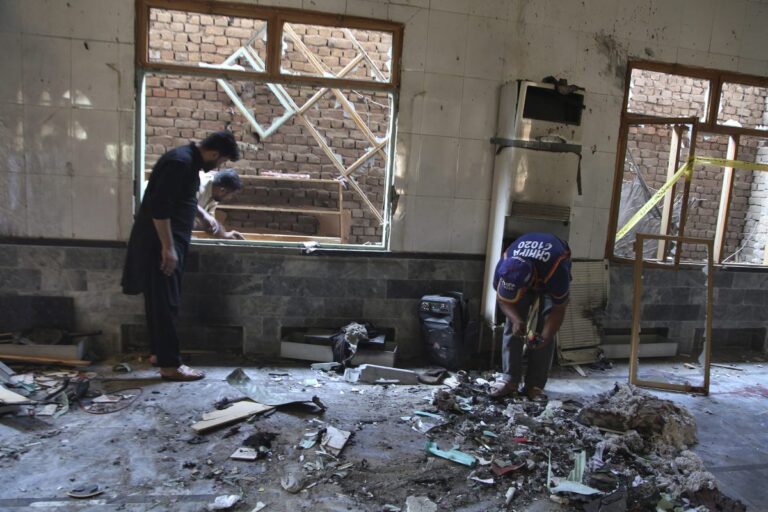Whatever might be claims, justifications and clarifications on the part of Pakistani authorities regarding its “hidden” support to Tehrik Taliban Afghanistan in re-capturing Kabul but now it also encouraging the fellow Pakistani militants. Stimulating extremism trends is now resulting hardships to Pakistani authorities both in and outside of the country.
Ending of New Zealand Cricket teams trip to Pakistan is the latest blow to Pakistani authorities efforts aimed at “getting recognition of Taliban regime” from the international community. And hoisting of Taliban flags over top of Lal Masjid at the federal capital Islamabad and armed Maulana Abdul Aziz portrait is another threatening message to rest of the world.
Since assuming power in Kabul by Taliban, violent acts across Khyber Pakhtunkhwa and certain pockets of Baluchistan are on the rise. Only in Waziristan region, over 16 violent occurred during first half of current September which caused lives to over thirty people including one dozen personnel of security forces. Likewise, militants attacks against the Chinese nationals at Khuzdar has also multiplied miseries of Chinese authorities who are still engaged in “finding out causes of deadly attacks against a group of engineers in Upper Kohistan on July 14th last.
In a period of one month, the students and academicians of government owned Lal Masjid, hoisted Afghan Taliban’s white colour flag, inscribed with Kalma Tayyaba generating stock of questions. It confirms that Talibanisation in Pakistan is being “patronized” by those who are in close links and support with hardliners. The Lal Masjid issue remain on headlines of global media in 2007 when former military dictator Pervez Musharaf ordered military action against its chief Maulana Abdul Rashid Ghazi. Though Ghazi was killed in the action and Abdul Aziz was caught when he had made an attempt to escape. For couple of years, the situation remained tense. However, later hidden brokered a secret deal between the two sides.
Since return of Taliban into power at Kabul, the hard line religious groups through one or the other ways are stimulating its activities. Besides others both the factions of Jamiat Ul Ulema Islam headed by Maulana Fazal Ur Rahman and Maulana Hamid Ul Haq (son of Maulana Sami Ul Haq) are in race to prove itself as “true patrons or friends” of Afghan Taliban. The JUI F is going to hold a national level gathering at Peshawar in mid of coming October. Likewise is the position of activists and stalwarts associated with banned Sepah Sahaba, using names of Jamaat Ahli Sunna, Pakistan Rah -i-Haq Party and others. Banned Jumat Ul Dawa of Hafiz Muhammad Saeed is holding “ Paigham-i-Pakistan” conference at Peshawar on Sunday (today) for extending congratulations to Afghan Taliban and re-affirming “warnings or threats” to India.
Apart from religious-politico groups and faction, banned Tehrik Taliban Pakistan sheltering across the border in Afghanistan has also intensified its terror-focused activities in parts and parcels of Khyber Pakhtunkhwa. The banned TTP chief Mufti Noor Wali is reportedly sheltering in Pakty-Paktika province of Afghanistan but almost his aides and loyal fighters are residing in Kunar and Nangarhar provinces bordering with Khyber, Mohmand and Bajaur tribal districts of Khyber Pakhtunkhwa. Most recently after unlocking of prisons at Kabul, Maulvi Faqir Muhammad top commander of banned TTP was welcomed like hero and brought to Kunar from Kabul in a motorcade procession. Around three thousands Pakistanis or other fighters of banned TTP have been released from Kabul and other prisons. So far other smaller groups like TTP Jumaat Ul Ahrar, Lashkar Islam of Mangal Bagh are silent but its fighters are extending help to Afghan Taliban as security guards in Kabul, Torkham, Jalalabad and rest of Afghanistan.
The issue of militants associated with the Islamic States (IS) also called Daaesh is also made further mysterious and complicated after evacuation of US led allied troops and return of Taliban into power. Besides, over three thousands militants earlier associated with banned TTP from Aurakzai, North and South Waziristan, Bajaur and Mohmand, the IS is also hosting hundreds of Uzbeks and other Central Asian Militants associated with East Turkistan Islamic Movement, Islamic Movement of Uzbekistan, Ittehad Islami Jihad and other group. Prior to fall of Afghanistan to Taliban all these CAR militants associated or linked with the IS shifted through a well planned ways from Eastern Afghanistan to Northern Afghanistan.
In the light of stimulating extremism and hardliners in the region, no other Pakistan seem on the target along with Afghanistan. No one can deny the fact that due to “mysterious” modus operandi on the part of US led allies during so-called war on terror after 9/11, the strength of terrorists increased instead of decreasing. And the increasing strength of terrorists and stimulating activities on the part of hard liners religious-politico circles likely to go ahead with continuation of terrorism and extremism trends in the region, especially border areas between the two neighbouring countries. And no other continuation of this “artificial terrorism” trends might be harmful to the very interests of Pakistan, especially Pakhtunkhwa connecting Islamabad and Kabul with each others.


